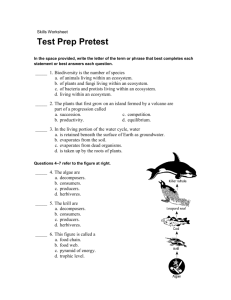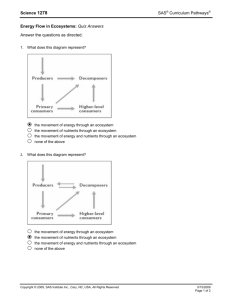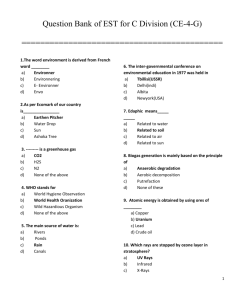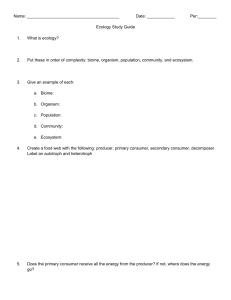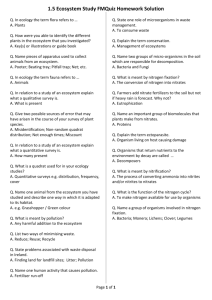chapter 57 reading questions
advertisement
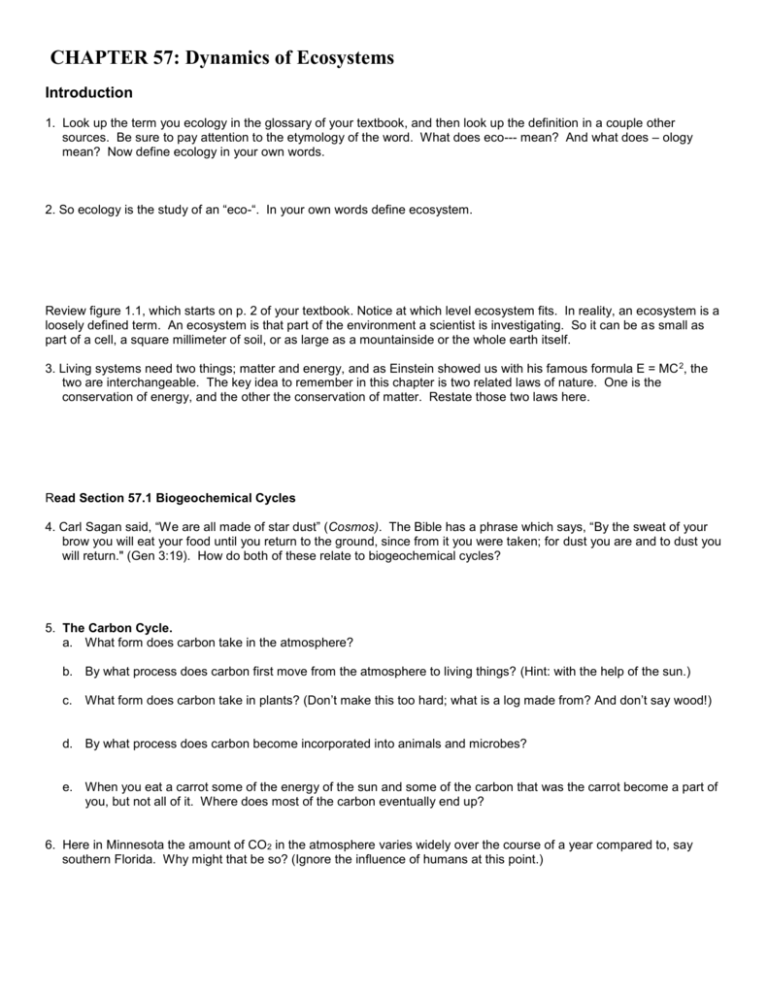
CHAPTER 57: Dynamics of Ecosystems Introduction 1. Look up the term you ecology in the glossary of your textbook, and then look up the definition in a couple other sources. Be sure to pay attention to the etymology of the word. What does eco--- mean? And what does – ology mean? Now define ecology in your own words. 2. So ecology is the study of an “eco-“. In your own words define ecosystem. Review figure 1.1, which starts on p. 2 of your textbook. Notice at which level ecosystem fits. In reality, an ecosystem is a loosely defined term. An ecosystem is that part of the environment a scientist is investigating. So it can be as small as part of a cell, a square millimeter of soil, or as large as a mountainside or the whole earth itself. 3. Living systems need two things; matter and energy, and as Einstein showed us with his famous formula E = MC 2, the two are interchangeable. The key idea to remember in this chapter is two related laws of nature. One is the conservation of energy, and the other the conservation of matter. Restate those two laws here. Read Section 57.1 Biogeochemical Cycles 4. Carl Sagan said, “We are all made of star dust” (Cosmos). The Bible has a phrase which says, “By the sweat of your brow you will eat your food until you return to the ground, since from it you were taken; for dust you are and to dust you will return." (Gen 3:19). How do both of these relate to biogeochemical cycles? 5. The Carbon Cycle. a. What form does carbon take in the atmosphere? b. By what process does carbon first move from the atmosphere to living things? (Hint: with the help of the sun.) c. What form does carbon take in plants? (Don’t make this too hard; what is a log made from? And don’t say wood!) d. By what process does carbon become incorporated into animals and microbes? e. When you eat a carrot some of the energy of the sun and some of the carbon that was the carrot become a part of you, but not all of it. Where does most of the carbon eventually end up? 6. Here in Minnesota the amount of CO2 in the atmosphere varies widely over the course of a year compared to, say southern Florida. Why might that be so? (Ignore the influence of humans at this point.) 7. The Water Cycle a. You’ve probably been drawing pictures of the water cycle since 1st grade so we’ll skip that part, except one piece. What term is used to describe the evaporation of water from plants? 8. The Nitrogen Cycle a. How do living systems use nitrogen? b. What form does nitrogen take in the atmosphere and what form does it need to be in to enter the biosphere? c. Describe how the figure to the right is significant to the nitrogen cycle. What is the process called that these organisms accomplish? d. I've noticed that farmers will plant corn one year, and then the following year he plants soybeans. Why? 9. Limiting Resource Like most of you I enjoy making s’mores when we're camping. Usually, someone brings a large box of graham crackers, a big bag of marshmallows, and a package of Hershey bars. There are usually six Hershey bars in the package. Most of us use half of a Hershey bar for each s'more, one or two marshmallows and one graham cracker. With my family, in only a short time there are usually plenty of marshmallows, and lots of graham crackers left over. a. In the situation described above, what is the limiting resource? 10. Describe how one limiting resource/nutrient can have a cascade effect on the whole ecosystem. Refer to the Hubbard Brook Experiment on p. 1195. Chapter 57.2 The Flow of Energy in Ecosystems Read the first section of "Energy flows through tropic levels of ecosystems" p. 1196 11. There are four prefixes and one suffix introduced in this section. Begin by defining each one separately: a. b. c. d. e. – troph Auto – Photo – Chemo – Hetero – 12. Using the definitions you came up with above, photoautotroph would translate to mean? 13. Again using the definitions from above chemoautotroph would translate to mean? Read the next section starting on p. 1196 Definitions of tropic levels 14. The previous section described how carbon and energy enter the “web of life”. When the suffix “-vore” is used what is that referring to? 15. What is the term for a linear “who-eats-who” in an ecosystem? 16. There are two sets of terms used to describe the flow of energy and carbon through an ecosystem. The trophic levels describe the flow of energy and the other describes where an organism is in the distribution chain. As in most economies (did you notice that word?) there is a poor guy at the bottom doing all the work. What is that level called? And what are the levels above that called? Read the first two parts of section 57.2. 17. List as many forms of energy you can think of (at least seven). 18. Do you remember the definition of energy you learned from physics? Energy is the ability to do work. What kind of work does a living organism do? What kind of work do the cells of that living organism do? 19. Consider the image below. What percentage of the energy from the leaf (200 J) goes to each process/product? 20. If the caterpillar gets eaten by a bird how much energy does the bird get? (Careful!) IS the bird eating GPP or NPP? 21. There are basically only two forms of energy living systems can use. What are they? Read How trophic levels process energy p. 1198 22. Why are there no trophic levels represented above the top carnivore? 23. On average herbivores deliver about 11% of their energy to the first level carnivore yet that carnivore only delivers 5.5% to the top carnivore? Why might that be? 24. Explain why an owl would have many food sources? Read Section 57.3 25. Why has the deer population in most of the upper Midwest exploded? 26. What are some of the additional effects besides just more deer? SECTION 57.4 Biodiversity and Ecosystem Stability Read Species richness may increase stability: Cedar Creek studies 27. What conclusion can you make from this data? (Which hypothesis is supported and why?)



